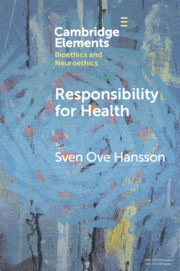52 results

Responsibility for Health
-
- Published online:
- 19 July 2022
- Print publication:
- 11 August 2022
-
- Element
- Export citation
Neuroethics for Fantasyland or for the Clinic? The Limitations of Speculative Ethics
-
- Journal:
- Cambridge Quarterly of Healthcare Ethics / Volume 29 / Issue 4 / October 2020
- Published online by Cambridge University Press:
- 07 September 2020, pp. 630-641
-
- Article
-
- You have access
- Open access
- HTML
- Export citation
Protection without Discrimination: Pregnancy and Occupational Health Regulations – ERRATUM
-
- Journal:
- European Journal of Risk Regulation / Volume 10 / Issue 1 / March 2019
- Published online by Cambridge University Press:
- 05 March 2018, p. 240
-
- Article
-
- You have access
- HTML
- Export citation
The Ethics of Making Patients Responsible
-
- Journal:
- Cambridge Quarterly of Healthcare Ethics / Volume 27 / Issue 1 / January 2018
- Published online by Cambridge University Press:
- 07 December 2017, pp. 87-92
-
- Article
-
- You have access
- HTML
- Export citation
Protection without Discrimination: Pregnancy and Occupational Health Regulations
-
- Journal:
- European Journal of Risk Regulation / Volume 7 / Issue 2 / June 2016
- Published online by Cambridge University Press:
- 20 January 2017, pp. 404-412
-
- Article
-
- You have access
- Export citation
2 - Nuclear energy and the ethics of radiation protection
- from Part I - Risk
-
-
- Book:
- The Ethics of Nuclear Energy
- Published online:
- 05 September 2015
- Print publication:
- 07 August 2015, pp 17-34
-
- Chapter
- Export citation
Medical Ethics and New Public Management in Sweden
-
- Journal:
- Cambridge Quarterly of Healthcare Ethics / Volume 23 / Issue 3 / July 2014
- Published online by Cambridge University Press:
- 02 June 2014, pp. 261-267
-
- Article
- Export citation
OUTCOME LEVEL ANALYSIS OF BELIEF CONTRACTION
-
- Journal:
- The Review of Symbolic Logic / Volume 6 / Issue 2 / June 2013
- Published online by Cambridge University Press:
- 16 January 2013, pp. 183-204
- Print publication:
- June 2013
-
- Article
- Export citation
A Resolution of Wollheim's Paradox
-
- Journal:
- Dialogue: Canadian Philosophical Review / Revue canadienne de philosophie / Volume 32 / Issue 4 / Fall 1993
- Published online by Cambridge University Press:
- 13 April 2010, pp. 681-688
-
- Article
- Export citation
The Dynamics of Norms, Christina Bicchieri, Richard Jeffrey, and Brain Skyrms (eds.). Cambridge University Press, 1997, 222 + x pages.
-
- Journal:
- Economics & Philosophy / Volume 15 / Issue 2 / October 1999
- Published online by Cambridge University Press:
- 05 December 2008, pp. 307-311
-
- Article
- Export citation
Three Bioethical Debates in Sweden
-
- Journal:
- Cambridge Quarterly of Healthcare Ethics / Volume 17 / Issue 3 / July 2008
- Published online by Cambridge University Press:
- 21 May 2008, pp. 261-269
-
- Article
- Export citation
PHILOSOPHICAL PROBLEMS IN COST–BENEFIT ANALYSIS
-
- Journal:
- Economics & Philosophy / Volume 23 / Issue 2 / July 2007
- Published online by Cambridge University Press:
- 31 July 2007, pp. 163-183
-
- Article
- Export citation
The Ethics of Enabling Technology
-
- Journal:
- Cambridge Quarterly of Healthcare Ethics / Volume 16 / Issue 3 / July 2007
- Published online by Cambridge University Press:
- 09 May 2007, pp. 257-267
-
- Article
- Export citation
ECONOMIC (IR)RATIONALITY IN RISK ANALYSIS
-
- Journal:
- Economics & Philosophy / Volume 22 / Issue 2 / July 2006
- Published online by Cambridge University Press:
- 11 July 2006, pp. 231-241
-
- Article
- Export citation
Bioethics in Sweden
-
- Journal:
- Cambridge Quarterly of Healthcare Ethics / Volume 15 / Issue 3 / July 2006
- Published online by Cambridge University Press:
- 02 May 2006, pp. 285-293
-
- Article
- Export citation
Equality and Priority
-
- Article
- Export citation
The Ethics of Biobanks
-
- Journal:
- Cambridge Quarterly of Healthcare Ethics / Volume 13 / Issue 4 / October 2004
- Published online by Cambridge University Press:
- 03 December 2004, pp. 319-326
-
- Article
- Export citation
Credibility limited revision
-
- Journal:
- The Journal of Symbolic Logic / Volume 66 / Issue 4 / December 2001
- Published online by Cambridge University Press:
- 12 March 2014, pp. 1581-1596
- Print publication:
- December 2001
-
- Article
- Export citation
Rights, risks, and residual obligations
-
- Journal:
- Risk, Decision and Policy / Volume 6 / Issue 3 / December 2001
- Published online by Cambridge University Press:
- 30 October 2001, pp. 157-166
- Print publication:
- December 2001
-
- Article
- Export citation



